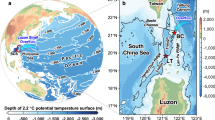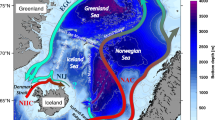Abstract
The overflows from the Nordic seas maintain the deep branch of the North Atlantic Ocean’s thermohaline circulation1,2, an important part of the global climate system3,4. However, the source of these overflows, and of overflow variability, is debated: proposals include open-ocean convection, dense-water production on the Arctic shelves and the gradual transformation of Atlantic water as it circulates the periphery of the Nordic seas and the Arctic Ocean2,5,6. Here we analyse time series of observed ocean temperature and salinity between 1950 and 2005. We find that the progression of thermohaline anomalies on interannual to decadal timescales does not support a systematic response of the overflow properties to convective mixing in the Greenland Sea as has been suggested7,8. Instead, anomalies in temperature and salinity that leave the northern seas at the Denmark Strait have travelled along the rim of the Nordic seas from inflow to overflow. Furthermore, the Faroe–Shetland Channel reflects the variability of an overturning loop within the Norwegian Sea that has not been observed previously. We thus conclude that the Atlantic water circulating in the Nordic seas is the main source for change in the overflow waters.
This is a preview of subscription content, access via your institution
Access options
Subscribe to this journal
Receive 12 print issues and online access
$259.00 per year
only $21.58 per issue
Buy this article
- Purchase on Springer Link
- Instant access to full article PDF
Prices may be subject to local taxes which are calculated during checkout




Similar content being viewed by others
References
Dickson, R. R. & Brown, J. The production of North Atlantic deep water: Sources, rates and pathways. J. Geophys. Res. 99, 12319–12342 (1994).
Hansen, B. & Østerhus, S. North Atlantic–Nordic Seas exchanges. Prog. Oceanogr. 45, 109–208 (2000).
Rahmstorf, S. Ocean circulation and climate during the past 120,000 years. Nature 419, 207–214 (2002).
Kleiven, H. F. et al. Reduced North Atlantic deep water coeval with the glacial Lake Agassiz fresh water outburst. Science 319, 60–64 (2008).
Mauritzen, C. Production of dense overflow waters feeding the North Atlantic across the Greenland–Scotland Ridge. Part 1: Evidence for a revised circulation scheme. Deep-Sea Res. I 43, 769–806 (1996).
Rudels, B., Friedrich, H. J. & Quadfasel, D. The arctic circumpolar boundary current. Deep-Sea Res. II 46, 1023–1062 (1999).
Schlosser, P., Bönisch, G., Rhein, M. & Bayer, R. Reduction of deepwater formation in the Greenland Sea during the 1980s: Evidence from tracer data. Science 251, 1054–1056 (1991).
Dong, B. & Sutton, R. W. Mechanism of interdecadal thermohaline circulation variability in a coupled ocean–atmosphere GCM. J. Clim. 18, 1117–1135 (2005).
Dickson, B., Meincke, J., Vassie, I., Jungclaus, J. & Østerhus, S. Possible predictability in overflow from the Denmark Strait. Nature 397, 243–246 (1999).
Nilsen, J. E. Ø., Hátún, H., Mork, K. A. & Valdimarsson, H. The NISE Data Set. Technical Report 08-01 (Faroese Fisheries Laboratory, Box 3051, Tórshavn, Faroe Islands, 2008).
Hansen, B. & Østerhus, S. Faroe Bank Channel overflow 1995–2005. Prog. Oceanogr. 75, 817–856 (2007).
Skagseth, Ø. et al. in Arctic–Subarctic Ocean Fluxes: Defining the Role of the Northern Seas in Climate (eds Dickson, B., Meincke, J. & Rhines, P.) 45–64 (Springer, 2008).
Blindheim, J. & Østerhus, S. in The Nordic Seas: An Integrated Perspective (eds Drange, H., Dokken, T. M., Furevik, T., Gerdes, R. & Berger, W.) 11–38 (Geophysical Monograph Series 158, American Geophysical Union, 2005).
Jonsson, S. & Valdimarsson, H. A new path for the Denmark Strait overflow water from the Iceland Sea to Denmark Strait. Geophys. Res. Lett. 31, L03305 (2004).
Olsson, K. A. et al. Intermediate water from the Greenland Sea in the Faroe Bank Channel: Spreading of released sulphur hexafluoride. Deep-Sea Res. I 52, 279–294 (2005).
Poulain, P.-M., Warn-Varnas, A. & Niiler, P. P. Near-surface circulation of the Nordic seas as measured by Lagrangian drifters. J. Geophys. Res. 101, 18237–18258 (1996).
Read, J. F. & Pollard, R. T. Water masses in the region of the Iceland-Færoes front. J. Phys. Oceanogr. 22, 1365–1378 (1992).
Søiland, H., Prater, M. D. & Rossby, T. Rigid topographic control of currents in the Nordic Seas. Geophys. Res. Lett. 35, L18607 (2008).
Curry, R. & Mauritzen, C. Dilution of the northern North Atlantic Ocean in recent decades. Science 308, 1772–1774 (2005).
Holliday, N. P. et al. Reversal of the 1960s to 1990s freshening trend in the northeast North Atlantic and Nordic Seas. Geophys. Res. Lett. 35, L03614 (2008).
Dickson, R. R., Meincke, J., Malmberg, S.-A. & Lee, A. J. The great salinity anomaly in the Northern North Atlantic 1968–1982. Prog. Oceanogr. 20, 103–151 (1988).
Dickson, B. et al. in Arctic–Subarctic Ocean Fluxes: Defining the Role of the Northern Seas in Climate (eds Dickson, B., Meincke, J. & Rhines, P.) 443–474 (Springer, 2008).
Olsson, K. A., Jeansson, E., Tanhua, T. & Gascard, J.-C. The East Greenland current studied with CFCs and released sulphur hexafluoride. J. Mar. Syst. 55, 77–95 (2005).
Furevik, T. On anomalous sea surface temperatures in the Nordic Seas. J. Clim. 13, 1044–1053 (2000).
Turrell, W. R., Slesser, G., Adams, R. D., Payne, R. & Gillibrand, P. A. Decadal variability in the composition of Faroe–Shetland Channel bottom water. Deep-Sea Res. I 46, 1–25 (1999).
Eldevik, T., Straneo, F., Sandø, A. B. & Furevik, T. in The Nordic Seas: An Integrated Perspective (eds Drange, H., Dokken, T. M., Furevik, T., Gerdes, R. & Berger, W.) 89–104 (Geophysical Monograph Series 158, American Geophysical Union, 2005).
Käse, R. H., Serra, N., Köhl, A. & Stammer, D. Mechanisms for the variability of dense water pathways in the Nordic Seas. J. Geophys. Res. 114, C01013 (2009).
Mauritzen, C. Production of dense overflow waters feeding the North Atlantic across the Greenland–Scotland Ridge. Part 2: An inverse model. Deep-Sea Res. I 43, 807–835 (1996).
Guemas, V. & Salas-Mélia, D. Simulation of the Atlantic Meridional Overturning Circulation in an Atmosphere-Ocean Global Coupled Model. Part I: A mechanism governing the variability of ocean convection in a preindustrial experiment. Clim. Dyn. 31, 29–48 (2007).
Rudels, B. et al. The interaction between waters from the Arctic Ocean and the Nordic Seas north of Fram Strait and along the East Greenland current: Results from the Arctic Ocean-02 Oden expedition. J. Mar. Syst. 55, 1–30 (2005).
Acknowledgements
This research was supported by the Norwegian Research Council through the projects ProClim, POCAHONTAS, BIAC and NorClim. The data were provided by the Marine Research Institute, Iceland; Institute of Marine Research, Norway; the Faroese Fisheries Laboratory; Geophysical Institute, University of Bergen, Norway; and the Arctic and Antarctic Research Institute, Russia, through the NISE project. The authors are grateful for discussions with numerous colleagues, particularly P. E. Isachsen, J. Lilly, K. Lygre, K. Oliver, Ø. Skagseth and D. J. Steinskog. This is publication No. A225 from the Bjerknes Centre for Climate Research.
Author information
Authors and Affiliations
Corresponding author
Rights and permissions
About this article
Cite this article
Eldevik, T., Nilsen, J., Iovino, D. et al. Observed sources and variability of Nordic seas overflow. Nature Geosci 2, 406–410 (2009). https://doi.org/10.1038/ngeo518
Received:
Accepted:
Published:
Issue Date:
DOI: https://doi.org/10.1038/ngeo518
This article is cited by
-
Role of air-sea heat flux on the transformation of Atlantic Water encircling the Nordic Seas
Nature Communications (2023)
-
Future strengthening of the Nordic Seas overturning circulation
Nature Communications (2023)
-
Upper ocean warming and sea ice reduction in the East Greenland Current from 2003 to 2019
Communications Earth & Environment (2023)
-
Impact of initialization methods on the predictive skill in NorCPM: an Arctic–Atlantic case study
Climate Dynamics (2023)
-
Horizontal circulation across density surfaces contributes substantially to the long-term mean northern Atlantic Meridional Overturning Circulation
Communications Earth & Environment (2021)



